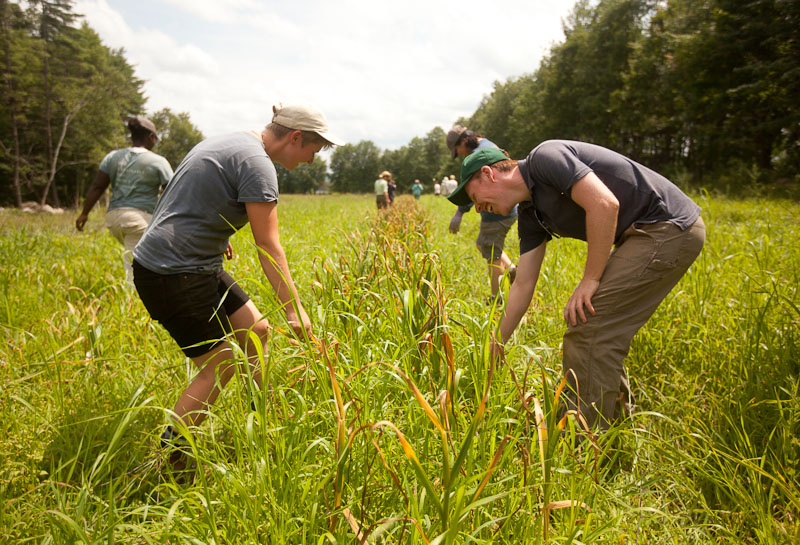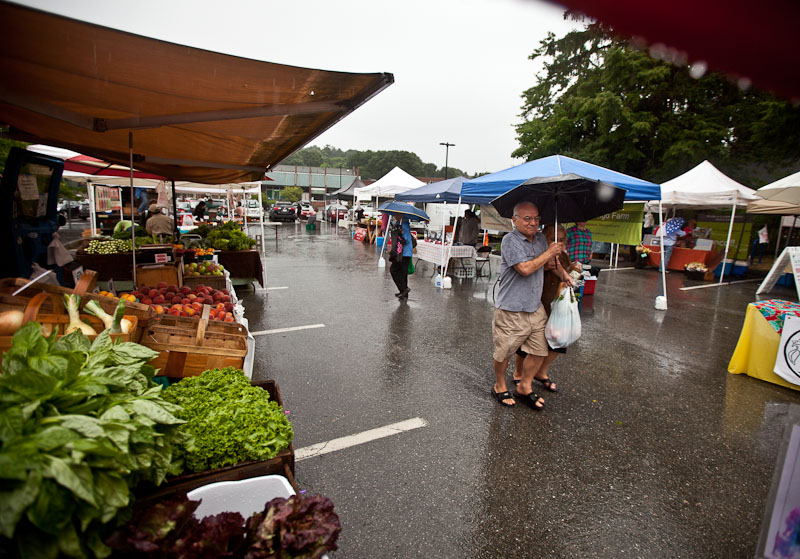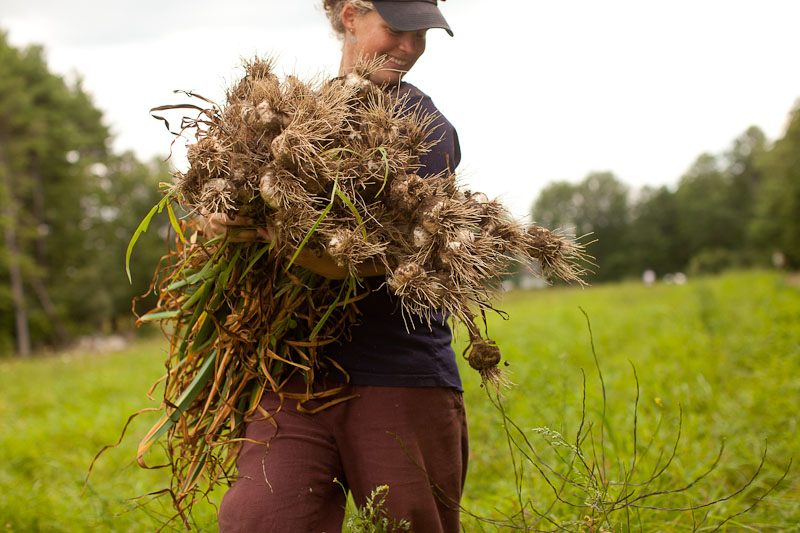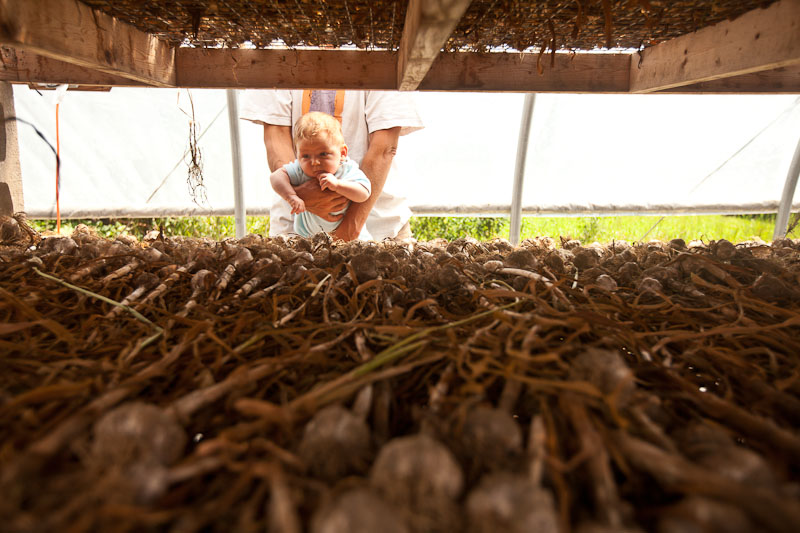In The Weeds
 Nine months ago, the hard-neck garlic went into the ground. We fifteen wide-eyed and eager student farmers, just weeks into our academic year, cased the immaculate field unbroken by latent weeds, its rows of square-shouldered beds unmarked by foot or trowel.The whole year lay ahead of us. We blessed, buried and patted each clove as we inched along the rows. A third of the way into the nine thousand-clove planting, we got a taste of the blisters and aching backs to come. But our morale soared. We were drunk on the novelty of dirty fingernails an afternoon working under the autumn sun.Since that November day, we’ve revisited our garlic field countless times: covering and uncovering it with mulch, digging through snow to check for green shoots, weeding and worrying and more endless weeding. And now, finally, August: harvest time.
Nine months ago, the hard-neck garlic went into the ground. We fifteen wide-eyed and eager student farmers, just weeks into our academic year, cased the immaculate field unbroken by latent weeds, its rows of square-shouldered beds unmarked by foot or trowel.The whole year lay ahead of us. We blessed, buried and patted each clove as we inched along the rows. A third of the way into the nine thousand-clove planting, we got a taste of the blisters and aching backs to come. But our morale soared. We were drunk on the novelty of dirty fingernails an afternoon working under the autumn sun.Since that November day, we’ve revisited our garlic field countless times: covering and uncovering it with mulch, digging through snow to check for green shoots, weeding and worrying and more endless weeding. And now, finally, August: harvest time. In case you haven’t noticed, it’s been a few weeks since I last checked in. Between dawn-to-dusk days at the farm, a few fleeting evening hours with my family, weekend chores, visitors and a ballooning sleep deficit, I’ve had little left over for reflection, let alone time for writing any of it down.But to try and catch you up briefly, the time has passed like this:Wet: Last month, we were pummeled by weeks of rain that drowned salad greens, stifled tomatoes, delayed planting and let weeds run wild while we waited for things to dry out. This created gaps in our CSA boxes, leaving us in the uncomfortable position of buying corn and blueberries from other farms.As a result, our head grower, Tyson, has had just as many sleepless nights as Dina and I – and we have an infant. But our farm’s struggles are not unique. Enterprise Farm (where Dina and I used to get our CSA share) wrote in their newsletter that this year has been the most challenging growing season they’d seen in 29 years.So we turn field after field of unmarketable vegetables back into the soil and hope that, for our customers, a bumper crop of tomatoes will erase memories of June and July’s lean pickings.Hot: As soon as the rains eased, we were gobsmacked by a smothering heat wave. And it wasn’t just the seven-day stretch of 95-degree days. The jungle-like humidity pushed the misery- and bugginess-index to a level I’ve never experienced.Never mind all that, though. We had to get our fields back in shape, so we ventured out each day, sweating through every dry stitch and misting ourselves with gallons of ‘natural’ (read: ineffectual) bug spray. One particularly swampy day spent transplanting, the sweat that poured from my arms and chest soaked my Carhartts clear below the knees. The lunch crew prepped jugs of switchel, a traditional New England concoction, familiar to hay farmers and vile to many, of water, black strap molasses, apple cider vinegar, salt and ginger. Fellow student-farmer Anne Cavanaugh described it as ‘a whipping from the inside.’ But martyrs we were not. This is Farm School, after all, so on the fifth-straight day of trellising unruly tomatoes, popsicles and ice cream were had by all.
In case you haven’t noticed, it’s been a few weeks since I last checked in. Between dawn-to-dusk days at the farm, a few fleeting evening hours with my family, weekend chores, visitors and a ballooning sleep deficit, I’ve had little left over for reflection, let alone time for writing any of it down.But to try and catch you up briefly, the time has passed like this:Wet: Last month, we were pummeled by weeks of rain that drowned salad greens, stifled tomatoes, delayed planting and let weeds run wild while we waited for things to dry out. This created gaps in our CSA boxes, leaving us in the uncomfortable position of buying corn and blueberries from other farms.As a result, our head grower, Tyson, has had just as many sleepless nights as Dina and I – and we have an infant. But our farm’s struggles are not unique. Enterprise Farm (where Dina and I used to get our CSA share) wrote in their newsletter that this year has been the most challenging growing season they’d seen in 29 years.So we turn field after field of unmarketable vegetables back into the soil and hope that, for our customers, a bumper crop of tomatoes will erase memories of June and July’s lean pickings.Hot: As soon as the rains eased, we were gobsmacked by a smothering heat wave. And it wasn’t just the seven-day stretch of 95-degree days. The jungle-like humidity pushed the misery- and bugginess-index to a level I’ve never experienced.Never mind all that, though. We had to get our fields back in shape, so we ventured out each day, sweating through every dry stitch and misting ourselves with gallons of ‘natural’ (read: ineffectual) bug spray. One particularly swampy day spent transplanting, the sweat that poured from my arms and chest soaked my Carhartts clear below the knees. The lunch crew prepped jugs of switchel, a traditional New England concoction, familiar to hay farmers and vile to many, of water, black strap molasses, apple cider vinegar, salt and ginger. Fellow student-farmer Anne Cavanaugh described it as ‘a whipping from the inside.’ But martyrs we were not. This is Farm School, after all, so on the fifth-straight day of trellising unruly tomatoes, popsicles and ice cream were had by all. Disillusioned: The stress, pace and sheer physical demands of the past few weeks drove more than a few of us to tears. But the pain hasn’t been without insight. Last Thursday, Nora and I loaded a truck with the best produce we could eek from the fields and drove to the Belmont farmers market, seventy miles east. The first few hours passed pleasantly enough: a band played, sunlight fell on happy customers, and we were on pace to have our first thousand-dollar day of the season. But at four-o’clock, the skies opened. Within minutes, we were thoroughly soaked, our produce largely ruined, shoppers scampered to the comfort of nearby grocery stores.Nora and I stood there shivering in the empty parking lot and shook our heads. Farming.For months we’d broken our backs, soaked and baked and sweat, fought deer, pests and weeds only to make $600 under a tent and then watch the rest get washed away by the rains – again. Maybe this is the most common story of farming – the ongoing dance with weather and unpredictability. But right then, the frustration-bordering-on-futility of farming came through in Technicolor. For all intents and purposes, this is an experiment for me – I’m a student. If instead it were my livelihood and only chance to feed my family, I would have hung my head in that rainstorm and cried.
Disillusioned: The stress, pace and sheer physical demands of the past few weeks drove more than a few of us to tears. But the pain hasn’t been without insight. Last Thursday, Nora and I loaded a truck with the best produce we could eek from the fields and drove to the Belmont farmers market, seventy miles east. The first few hours passed pleasantly enough: a band played, sunlight fell on happy customers, and we were on pace to have our first thousand-dollar day of the season. But at four-o’clock, the skies opened. Within minutes, we were thoroughly soaked, our produce largely ruined, shoppers scampered to the comfort of nearby grocery stores.Nora and I stood there shivering in the empty parking lot and shook our heads. Farming.For months we’d broken our backs, soaked and baked and sweat, fought deer, pests and weeds only to make $600 under a tent and then watch the rest get washed away by the rains – again. Maybe this is the most common story of farming – the ongoing dance with weather and unpredictability. But right then, the frustration-bordering-on-futility of farming came through in Technicolor. For all intents and purposes, this is an experiment for me – I’m a student. If instead it were my livelihood and only chance to feed my family, I would have hung my head in that rainstorm and cried. So where does this leave me? It’s too early (and I’m probably too tired) to say. Idealism and uncertainty have been my constant warring companions since day one at Farm School. But there was something about the garlic fields, now unrecognizable through the weeds – that unsettled me. We pulled off a great crop. The garlic came in quickly, our bodies harder and stronger by our year of work. Harder and stronger, yes, but the bone-tired feeling now deep in our muscles gave an edge to the sweetness of our harvest.I love this work. I believe in it. I think I’m good at it. But growing food for money and not for the miracle of it can have the same relentless feeling of a nine-to-five – this one with no guarantee of a payday. In part, Dina and I started down this road because we feel at our richest with a good meal and loved ones to share it with. But when the work of growing means eating peanut butter on a fork for dinner and putting off friends until winter, the virtue in the work is drowned by weariness and is, at the very least, unsustainable. No declarations yet, but these days, that point feels uncomfortably close.
So where does this leave me? It’s too early (and I’m probably too tired) to say. Idealism and uncertainty have been my constant warring companions since day one at Farm School. But there was something about the garlic fields, now unrecognizable through the weeds – that unsettled me. We pulled off a great crop. The garlic came in quickly, our bodies harder and stronger by our year of work. Harder and stronger, yes, but the bone-tired feeling now deep in our muscles gave an edge to the sweetness of our harvest.I love this work. I believe in it. I think I’m good at it. But growing food for money and not for the miracle of it can have the same relentless feeling of a nine-to-five – this one with no guarantee of a payday. In part, Dina and I started down this road because we feel at our richest with a good meal and loved ones to share it with. But when the work of growing means eating peanut butter on a fork for dinner and putting off friends until winter, the virtue in the work is drowned by weariness and is, at the very least, unsustainable. No declarations yet, but these days, that point feels uncomfortably close. More photos from the heat, rain and harvests can be found HERE.
More photos from the heat, rain and harvests can be found HERE.
